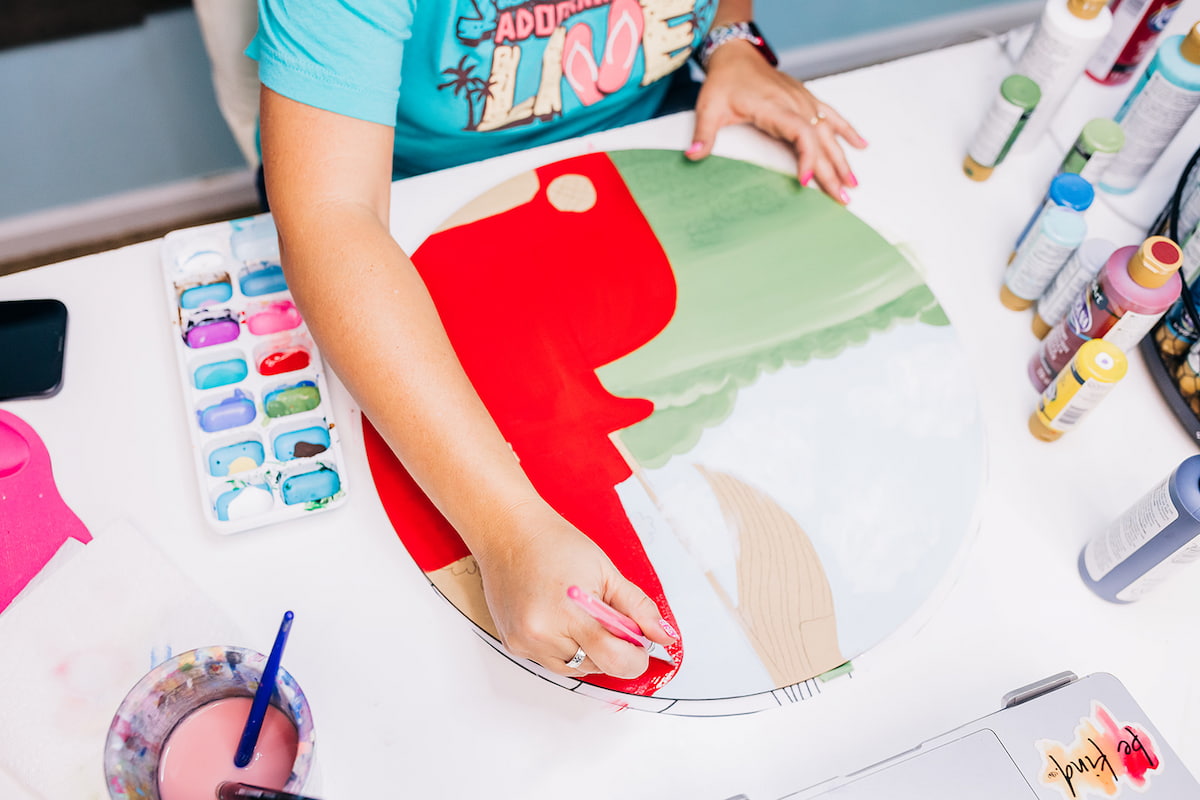Some of the links shared in this blog post are affiliate links. This means I make a small commission when you purchase through these links at no extra cost to you. All opinions and reviews shown are honest and my own. Thank you for supporting my small business!
As any painter or experienced crafter knows, you’re bound to run into some issues with your paint. I LOVE acrylic paint — it’s the most common paint I use in my door-hanger business. And it’s what I encourage others to use, too!
But there are some things I don’t love so much about it. Sometimes the paint is too thick. Or it dries and clumps up easily. And depending on what brush I use with it, it can get textured pretty easily (not ideal for smooth door hangers!).
All of this can be really frustrating when you’re in the zone, painting away! But it is totally normal.
So in this post, I’m going to show you solutions to four of the most common acrylic paint problems! Keep this post handy for your next project, and you’ll always remember how to make the most of your paints.
Acrylic Paint Problem #1: Paint Boogers
Okay, I know this sounds kind of funny…but you know what I mean! This is when the paint clumps together, usually in the cap. It usually happens because the paint has been left out for too long or the bottle wasn’t closed properly.
When acrylic paint is exposed to too much air for too long, the texture will change, so make sure you close your bottles all the way when you’re done!
In the meantime, a good shake-up or scraping out the paint from the cap will do the trick!
Acrylic Paint Problem #2: The Paint is too thick
Acrylic paint can be a little too thick at times, which can keep you from getting that ultra-smooth background you want on your door hangers. Whether it’s because your paint has been sitting on your palette for too long, or the paint itself is old, it happens!
To loosen things up, I spray my paint with a spray bottle before getting started. But you don’t want to pour too much water into your paint; otherwise, it will be too thin. (If you want a good recommendation on a spray bottle, you can grab one from my Amazon favorites here!)
(Psssst…this will also help keep your paint from becoming too textured.)
Acrylic Paint Problem #3: Paint ridges
Oh…the dreaded paint ridges. This is one of the most common problems I see new painters make, but fear not! It’s an easy fix.
Ridges typically come from having too much paint on your brush. It’s hard to stay in the lines, and forces you to have heavy-handed, pulling brush strokes, instead of light, smooth ones.
The fix? Just keep it light! Don’t get too much paint on the brush when dipping it in the paint. If you run out of paint on the brush, just flip it over to the other side. THEN re-dip your brush into the paint.
Acrylic Paint Problem #4: Messes and mistakes
Now, this is bound to happen to anyone regardless of what type of paint you use. Thankfully, acrylic paint is really easy to clean up!
Whether you accidentally painted outside the lines, dropped your brush and splattered paint, or simply want to restart those fine lines and details towards the end, keep a damp baby wipe handy.
All you have to do is wipe up the paint, and if need be, scrub ever so slightly (not too much pressure, otherwise you’ll scrub off the base coat underneath).
It’s easy, quick, and the reason why baby wipes are a MUST-HAVE in my craft room!
Put your acrylic paint skills to the test!
So, now that you know how to keep your paint in tip-top shape, it’s time to put those skills to the test!
Below, you’ll see a FREE tutorial on how to paint a beautiful springtime flower, start to finish. If you’re new to creating your own door hangers, or want a few more painting best practices, you’ll have a good opportunity to learn more here.
Grab the free tutorial in the video below!



0 Comments